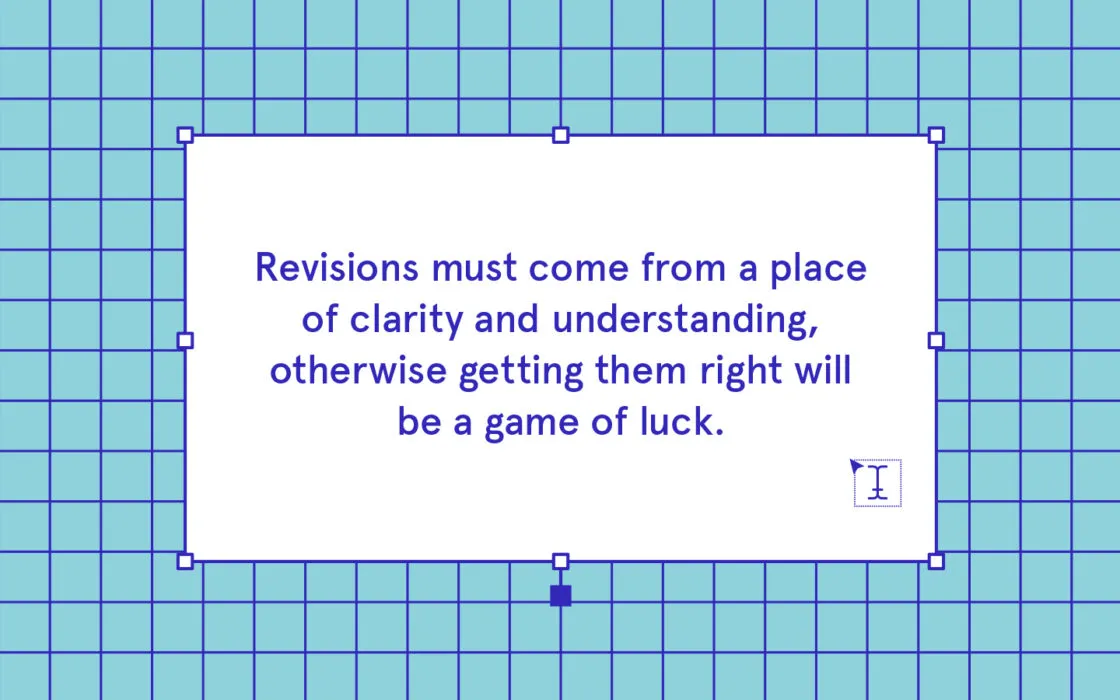It is said that there are only two certainties in life: death and taxes. For creatives, there are three—the third being revisions.
Article originally published in The Serious Review

Handling revisions require a certain amount of resilience and endurance physically, mentally and emotionally. To separate one’s work with oneself becomes more difficult when projects don’t turn out the way you expect them to, take longer to finish, or worst-case scenario: get scrapped. When things turn out this way, it feels as if you are alone, but you’re not. It helps to be reminded from time to time how the creative community shares the struggles of these projects—or the lack thereof.
As such, Escolta Block organized an event called ReVision, where our studio was invited to speak along with creatives from other industries, to talk about the realities and struggles of handling revisions and rejections while learning from the process along the way.
Here is a summary of the things we have learned from the crazy world of revisions so far:

1. Find a client that gets you
In an ideal world, you’d only be signing on with clients who understand how you work and what you believe and value in; they just get it. More often than not though, that isn’t the case, but that shouldn’t have to be a bad thing. It’s then very important to create situations for yourself to be heard and understood. For a client to get you, you have to speak out and keep lines of communication open.
The success of a project begins on how you approach it from the get-go. Before getting any actual work done, align your expectations with the client’s and be transparent with your process. When you set such—what you do and don’t do—that allows you to transparently put your foot down on the standards of how you work. Revisions are usually the results of misalignment, so clarifying all bases during all phases of the project will equip both you and your client to constantly be on the same page. Being in agreement with each other from the start ensures a stronger working foundation, mutual trust and understanding.
2. Revisions bring you closer to the objective
When revisions arise, it is easy to become reactive to the situation. If it keeps happening, it can get to a point of confusion, like aimlessly shooting blindly and hoping that the next shot will get it right. When you find yourself in this situation, it is time to take a step back and re-evaluate. Are you still fulfilling what you set out to do in the first place? If not, gauge the situation at hand.
Two kinds of revisions: Irrational and Rational
Irrational Revisions
“I’m not feeling it.” “I’ll know it when I see it.” “This doesn’t stand out.” Sound familiar? Irrational revisions are broad and vague comments to your work. Most of the time, when you proceed guessing, the usual turnout does not go well.
Revisions must come from a place of clarity and understanding, otherwise getting it right will be a game of luck. The best way to deal with this is to ensure that you maintain control over your project, whatever the circumstance. Create the conditions to narrow down and to specify the seemingly broad and vague. When in doubt, ask. Don’t be afraid to list follow-up questions. Go on a call. Set a meeting. Compile a moodboard. Do what it takes for you to understand what you are dealing with.
Another way to narrow down is to set revision rounds and to charge accordingly. Treat revision rounds like genie wishes to be used wisely; they need to be smart, comprehensive and concise. Before revising based on feedback, make sure to compile all of them in one round than many separate ones. These agreements should be firmly established if your project was properly aligned from the start, ultimately keeping you protected all throughout.

Rational Revisions
Rational revisions are strongly tied to the objectives of the brand. It is to question if your current work fulfills what the project was set out to do. Like irrational revisions, the way to go about this is to be in close communication with the client. Remember that revisions are not inherently bad and they can help improve the project when approached correctly. Discuss and defend your take, but also keep an open mind and listen to what your client has to say. Going back to the objective will help you defend, refine or change your work more intentionally and productively. When approached in this way, a revision becomes an invitation to re-envision—an opening up of a new possibility that grows and evolves after iterating and learning from your past work.
3. Different strokes for different folks
Dealing with revisions better is to learn the art of being a client whisperer—understanding that there are different client situations with different needs. Knowing the situation that you are dealing with will help you deal with revision situations accordingly. Below are some commonly known kinds of client situations, and how to deal with them.
Indecisiveness
Not sure of what they want, they will keep asking for more options or may respond vaguely when it comes to feedback. This comes from a place of uncertainty which is why you should approach the project constantly with both clarity and conviction.
Clarity comes in the form of presenting your work and ideas while reminding your client the following: the objectives, the context, the problems you are aiming to solve, and how they were addressed in your work. When clients understand the intentionality behind your project, it can give them an assurance that you have covered all your bases, which can help you gain their trust. Guesswork is lessened when a client knows that your work is not mere ornamentation, but a thoroughly thought-out plan.
However, bulletproof rationales can only do so much. There will be clients who will say that the work doesn’t speak to them, and at this point, it will be harder to keep arguing against what they think. They will ask for more options and, if addressed reactively, can be frustrating to both parties. Instead of immediately providing options for the sake of, step back and organise your thoughts. Take note that merely showing a barrage of options can overwhelm, while showing too little can lead to an endless loop of “Can you show me more?” Coming up with smart options helps cancel out the what if’s inside your client’s head. So rationalize and categorize by providing the strengths of each option. A finishing touch to this would be to suggest your recommended choice and why it is the best route to fulfilling the objectives. This certainty and confidence usually puts you into a position of a consultative partner rather than a mere supplier, which is usually appreciated by clients who need a little help and guidance when it comes to making approval decisions.
Decision by Committee
Similar to the first, they need assurance that they are making the correct decisions. They then defer to outside opinion to get feedback or to help them articulate why something isn’t working out. The danger of this is that feedback can come in out of context from people who don’t necessarily know where the project progress is at. At times like these, it is important to show your clients that you can handle their business for them. You don’t necessarily have to follow every voice that comes in with feedback. But instead of merely canceling out and ignoring every unnecessary voice, it’s a great exercise to understand these comments, know which constructively makes sense amidst the sea of unnecessary or irrational ones, provide your arguments for the latter, and stand firm. When you know how to assert and answer against every point of feedback and bring it back to the objectives of the project, you gain the trust of your client by showing them that you know what you are doing.
Micromanaging
Micromanaging comes from a place of anxiety in uncertainty. No client wants to fail a project, so the tendency is to want to control every part of the process. Provide an environment of reassurance, confidence and communication to your project. Keeping your client updated every step of the way and guiding them throughout the process help give peace of mind that you are on top of the project.
The common requirement to address these three kinds of situation is to speak out. Speak now or forever hold your peace. It will surprise you how much transparency and honesty can help you move forward in a project. Express confidence and stick to your carefully considered strategies to help gain client trust. Listen to the client, but also learn how to command the respect to be listened to as well. You were hired for a reason, so remind your client and yourself that you share the control.
4. Remember that there is a finish line
Some finish lines are closer than others. In our seven years of operation, our projects have ranged from an approval time of 15 minutes to 2 years. No matter how long it can take, knowing that a finish line is at bay can help you endure the process better.
However, beyond the markers of success, finish lines may also come in the form of canceled and rejected projects. These are projects that won’t be able to see the light of day, whether or not blood and tears have been shed. These projects, perceived as failure and mistakes, are the hidden, barely discussed sides of ourselves as creatives.
Whatever the case may be, the most important thing to remember in this crazy world of revisions is to not let the work you do define who you are as a person. The successes and failures in your career are not representative of the life that you live. When dead ends come your way, you can break down, breathe, or take a break. Allow yourself to go through the motions of the creative struggle, but remember that failures only come in the form of projects, not yourself.
It also helps to remember that we all share the struggle of being creatives. Nobody has everything figured out. It is a relief to feel seen, heard and understood. So when the pang of self-doubt and sense of failure start kicking in, keep yourself company with a community that can support and hear you. Make friends from the industry, attend workshops and talks, create your version of alcoholics anonymous (but for creatives). To be reminded that you are not alone in what you feel can provide the comfort to keep moving forward until you get your momentum back up again.

5. Our worst client: Ourselves
Lastly, the inevitability of client revisions cannot be helped. Surely, the veterans of the field still probably go through revisions, except that experience makes them better at knowing how to handle them. While this reality seems exhausting, accepting it will help you set your expectations.
That is why self-initiated projects are encouraged—to give yourself opportunities for “less revisions.” You stretch out the capabilities of what you can do and you don’t have to worry about anybody else’s opinions but yours. Having self-initiated projects is the voice that allows you to be fully and uncompromisingly yourself—and that in itself is the reward. If you must have a worst client, let it be yourself. Because in your life as a creative, you should be able to dictate for yourself the work that defines you and matters to you the most. Self-initiated work reminds you why you do what you do, and that you are in control of your life as a creative. In the crazy world of revisions, find solace in yourself and what you do. You owe it to yourself.

